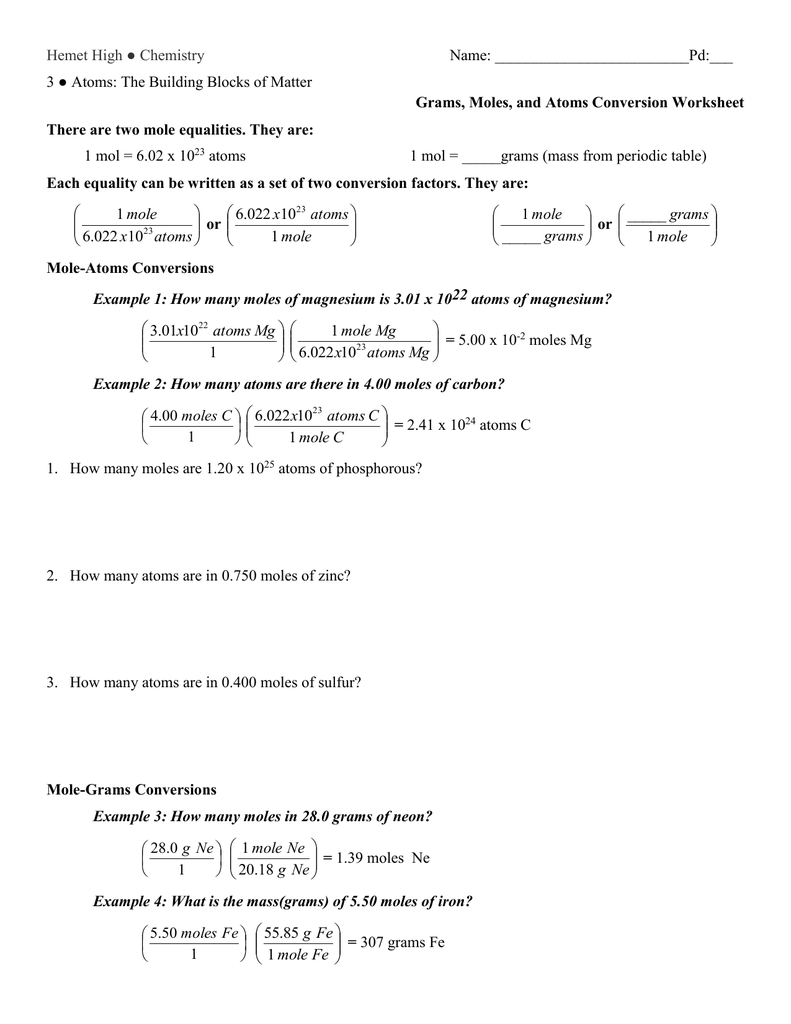Have you ever wondered how scientists can count the incredibly tiny particles that make up everything around us? It’s not as simple as using a magnifying glass! Enter the mole, a unit that allows us to bridge the gap between the macroscopic world we see and the microscopic world of atoms and molecules.
This worksheet will guide you through the fascinating world of mole conversions, helping you decipher the relationship between moles, particles, and grams.

Image: www.pinterest.es
Understanding the Mole: A Foundation for Chemical Calculations
Imagine a room full of people. It’s easier to say “there are 100 people in this room” rather than listing each individual’s name, right? The mole is like a collective noun for particles, a convenient way to represent massive quantities of atoms, molecules, or ions. One mole (mol) always contains 6.022 x 1023 entities. Think of it as the chemist’s version of a “dozen” but on a much grander scale.
This massive number is famously known as Avogadro’s number, named after Amedeo Avogadro, the Italian scientist who proposed that equal volumes of gases at the same temperature and pressure contain the same number of molecules. Avogadro’s number is a fundamental constant in chemistry, much like the speed of light in physics.
Key Concepts: Moles, Particles, and Grams
Before delving into conversions, let’s solidify the core relationships:
- Moles (mol): Represent a specific quantity of particles (atoms, molecules, etc.).
- Particles: The individual entities that make up a substance (atoms, molecules, ions).
- Grams (g): Measure the mass of a substance. The mass of one mole of a substance is its molar mass.
The Power of Conversion: Connecting Moles, Particles, and Mass
The beauty of the mole lies in its ability to link different quantities. We can seamlessly convert between the number of moles, the number of particles, and the mass of a substance using two key relationships:
- Moles and Particles:
1 mole = 6.022 x 1023 particles. - Moles and Mass: The molar mass of a substance (in grams per mole) tells us the mass of one mole of that substance. For example, the molar mass of water (H2O) is 18.02 g/mol. This means one mole of water weighs 18.02 grams.

Image: db-excel.com
Mastering Mole Conversions: A Step-by-Step Guide
Now, let’s equip you with the tools to confidently tackle mole conversion problems. Here’s a breakdown of common conversions:
1. Moles to Particles:
To convert from moles to particles, use the following formula:
Number of Particles = Moles x Avogadro’s Number
Example:
How many particles are in 2.5 moles of carbon dioxide (CO2)?
Number of Particles = 2.5 mol x 6.022 x 1023 particles/mol = 1.5055 x 1024 particles
2. Particles to Moles:
To convert from particles to moles, use this formula:
Moles = Number of Particles / Avogadro’s Number
Example:
How many moles are present in 4.5 x 1025 molecules of glucose (C6H12O6)?
Moles = 4.5 x 1025 molecules / 6.022 x 1023 molecules/mol = 74.75 mol
3. Moles to Mass:
To convert from moles to grams, use this formula:
Mass (g) = Moles x Molar Mass (g/mol)
Example:
What is the mass of 3.2 moles of sodium chloride (NaCl)?
First, find the molar mass of NaCl:
Sodium (Na): 22.99 g/mol
Chlorine (Cl): 35.45 g/mol
Total Molar Mass (NaCl): 22.99 g/mol + 35.45 g/mol = 58.44 g/mol
Then, calculate the mass:
Mass = 3.2 mol x 58.44 g/mol = 187.01 g
4. Mass to Moles:
To convert from grams to moles, use this formula:
Moles = Mass (g) / Molar Mass (g/mol)
Example:
How many moles are in 100 grams of calcium carbonate (CaCO3)?
First, find the molar mass of CaCO3:
Calcium (Ca): 40.08 g/mol
Carbon (C): 12.01 g/mol
Oxygen (O): 16.00 g/mol (x 3 = 48.00 g/mol)
Total Molar Mass (CaCO3): 40.08 g/mol + 12.01 g/mol + 48.00 g/mol = 100.09 g/mol
Then, calculate the moles:
Moles = 100 g / 100.09 g/mol = 0.999 mol
Real-World Applications: From Chemistry Lab to Everyday Life
Mole conversions aren’t just confined to textbooks and labs. They have numerous applications in various fields:
- Pharmaceuticals: Calculating the precise amounts of ingredients needed to manufacture medications relies on mole conversions.
- Environmental Science: Determining the concentration of pollutants in water or air often requires converting between moles and mass.
- Agriculture: Understanding fertilizer requirements for crops involves calculating the moles of nutrients needed.
- Food Science: Mole conversions play a role in controlling the proportions of ingredients in food products.
Beyond the Basics: Exploring Challenging Applications
As you delve deeper into chemistry, you’ll encounter more complex applications involving mole conversions, such as:
- Stoichiometry: Using mole ratios to calculate the amounts of reactants and products in chemical reactions.
- Solution Chemistry: Calculating the concentrations of solutions in terms of molarity (moles per liter).
- Gas Laws: Relating the volume, pressure, and temperature of gases to the number of moles.
Mole Conversions Worksheet Working With Moles And Particles
Conclusion: Unlocking the Secrets of Chemical Calculations
Mastering mole conversions is a critical skill for anyone working with chemicals, whether in a laboratory, a manufacturing facility, or even in your kitchen. By understanding the relationships between different units, we can confidently navigate the world of chemistry and unlock the secrets of the microscopic particles that make up everything around us. So, grab your calculator, open your worksheet, and get ready to explore the fascinating world of moles!





